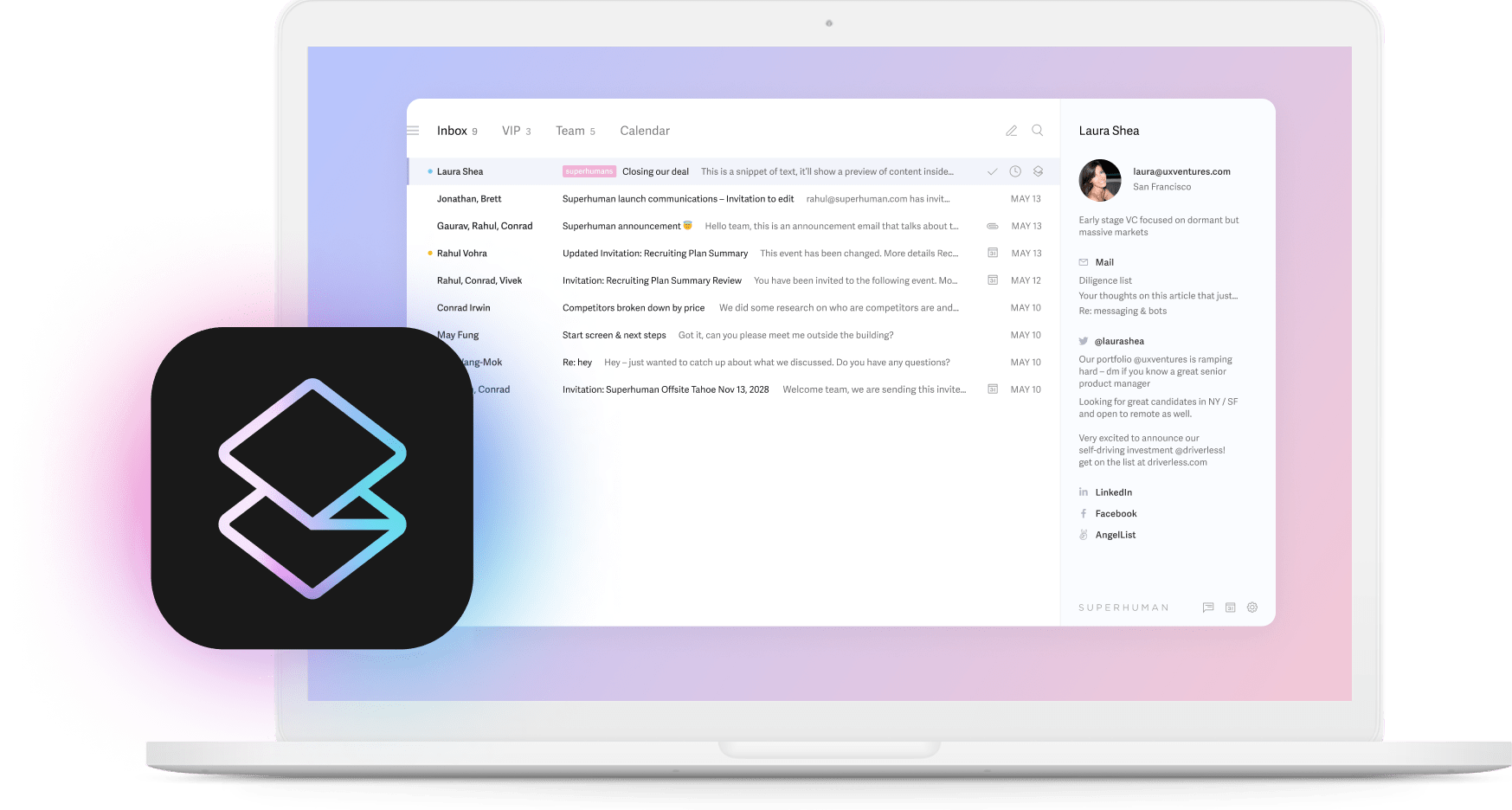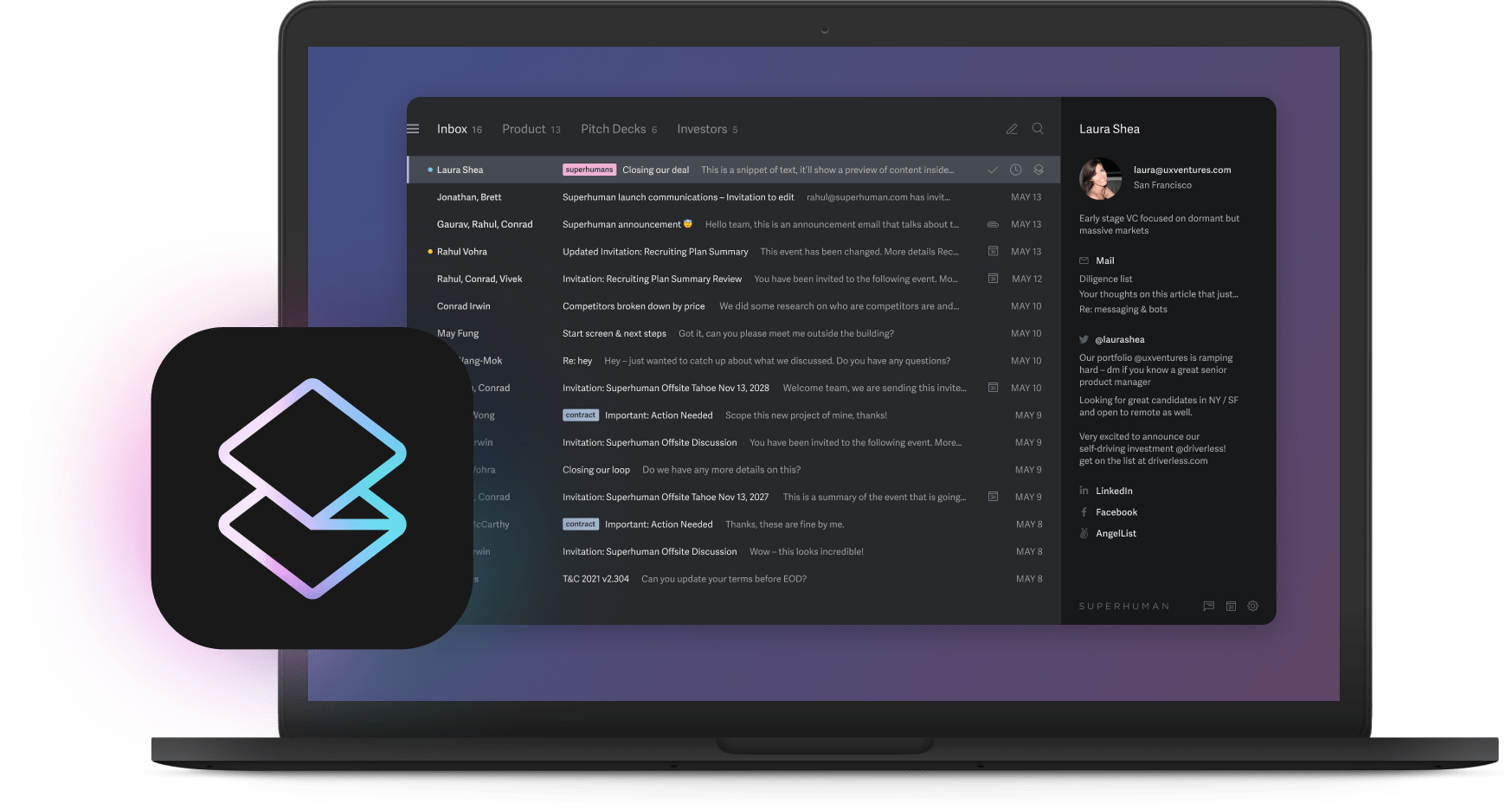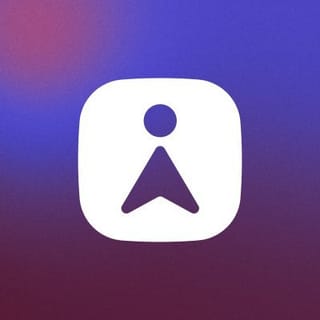
Executives who save 4 hours weekly compress their morning routine from two hours to 15 minutes. That's 200 hours reclaimed annually, enough time to launch a new product line or take that sabbatical.
While others perfect their meditation pose, these leaders have already scanned for fires, made key decisions, and shaped their entire day. They've discovered what two-hour morning routines miss: execution beats optimization.
Based on patterns from thousands of high-performing executives, here's exactly how to create a productive morning routine that delivers measurable results.
Quick-start: your 15-minute checklist
This protocol requires Superhuman's AI-native capabilities. Standard email clients can't replicate this workflow.
Tomorrow morning, try this exact sequence. Each step builds on the previous one, creating momentum that carries through your entire day.
Open Superhuman's Split Inbox and search urgent OR crisis to catch customer escalations, system alerts, or deadline shifts
Archive everything else by pressing E to achieve instant inbox clarity
Reply to your top three priorities using Superhuman's Instant Reply with R
Draft one strategic message with Superhuman AI and schedule it with Smart Send for optimal delivery
Teams using this exact protocol process email 72% faster. These AI-native features transform inbox management from reactive scrambling to proactive control. No meditation required.
The morning-routine industrial complex: why 2-hour rituals fail real executives
You've tried the elaborate morning routines. Journaling, meditation, supplements, exercise. The full prescription requires 90-240 minutes daily. But something feels wrong. While you're optimizing yourself, deals are closing without you. Teams await direction. Competitors grab opportunities.
The math reveals why these routines fail executives. Two hours daily equals 500 hours annually. During those 500 hours, your organization moves forward without your input. Critical decisions get delayed. Momentum stalls. The very routine meant to enhance performance actually impairs it by removing you from the game when stakes are highest.
The most effective executives take a different approach. They don't need two hours to prepare for battle because they've built systems that keep them battle-ready. They invest in AI-native tools and workflows that compress decision-making, allowing them to transition from rest to execution in minutes, not hours. Standard email platforms can't match this efficiency. The question isn't how long your routine should be. The question is how quickly you can reach peak decision-making capability.
The ROI of minutes: why 15 beats 120
Why exactly 15 minutes? Because cognitive science shows that focused attention peaks in short bursts. Your brain processes information most efficiently in 15-20 minute intervals. Beyond that, returns diminish rapidly. You're aligning your routine with your neurology, not rushing through tasks.
The compound effect transforms these 15 minutes into massive value. When you respond to critical issues immediately, you prevent escalations that would consume hours later. When you communicate priorities early, your entire organization aligns faster. When you catch problems at the signal stage, you avoid the noise stage entirely. Each minute invested in the morning saves 10-20 minutes throughout the day.
This multiplication effect explains the dramatic results. Superhuman customers collectively save 15 million hours annually not because they type faster, but because early action prevents later friction. A 15-minute investment that saves four hours weekly delivers a 16:1 return. Find another activity with that ROI.
Minute-by-minute deep dive: the power protocol
This protocol solves your biggest morning challenge: processing overwhelming information into clear action. Each phase addresses a specific need while building toward decisive leadership.
Minutes 1-5: intelligence scan
Your inbox contains both threats and opportunities, but they're buried in noise. This phase filters signal from static. Open Split Inbox and run: urgent OR crisis OR revenue OR escalation. This query catches customer cancellations, system outages, contract deadlines, and team escalations before they explode.
Why this works: You're pattern-matching against known risk indicators. Apply Instant Reply to anything requiring immediate action. Use Auto Summarize on complex conversations. Star exactly three items for deeper focus. Archive everything else. Superhuman's AI-native capabilities process context 10x faster than manual scanning, preventing 90% of daily surprises.
Minutes 6-10: command center check
Email reveals symptoms, but dashboards show root causes. This phase shifts from reactive to predictive. Open your primary dashboard (bookmark it for instant access). Focus on three metrics that predict tomorrow's problems: pipeline velocity, customer health scores, and team capacity.
Why these three: They're leading indicators. When pipeline slows, revenue problems follow. When customer health drops, churn accelerates. When team capacity strains, execution suffers. Use Read Statuses to verify critical messages were received. This Superhuman feature shows exactly who's engaged with your communications, enabling proactive follow-up. You're now seeing around corners, not just responding to what's visible.
Minutes 11-15: strategic narrative
Information without communication is worthless. This phase converts insights into organizational influence. Open Superhuman AI and draft one message that shapes your company's day. Examples: "Three priorities for this week" or "Revenue tracking ahead of plan."
Why one message matters: It forces prioritization and ensures clarity. Use Snippets for consistency. Schedule delivery with Smart Send when recipients are most likely to engage. Include specific recognition to reinforce culture. You've now set direction, communicated priorities, and influenced outcomes all before your first meeting.
Integration magic: from inbox to mission control
Your morning routine fails when tools work in isolation. Success requires connection. When you star a customer escalation, your CRM should flag the account automatically. When metrics shift, your communication tools should enable instant updates. When patterns emerge, AI should surface them immediately.
This integration transforms 15 minutes into executive advantage. One action triggers multiple outcomes. A single email scan updates your mental model, your dashboards reflect priorities, and AI drafts responses using your past successes as context. What took 15 separate actions now takes one.
The setup requires initial investment, typically 2-3 hours of configuration. But the payoff is immediate. Organizations report 40% faster decision-making when their tools operate as one system instead of many. Your morning routine becomes a force multiplier, not just a task list.
Failure modes and troubleshooting
Every system breaks. Here's how to fix yours before it does.
Skipping days kills momentum because habits require consistency. Set a recurring calendar block and treat it as non-negotiable. When you miss one day, friction compounds. Miss three days and you're back to reactive mode.
Information overload persists when filters fail. If you finish with more than 10 starred emails, your search queries are too broad. Refine weekly by analyzing what you starred versus what truly mattered. The goal is precision, not coverage.
Emotional reactions derail everything. That angry email at 6 a.m. can destroy your entire day if handled wrong. Before responding, use Superhuman AI tone adjustment. Let technology be your emotional buffer. Extreme time pressure demands adaptation, not abandonment. Create a 5-minute emergency protocol: one-minute scan, two-minute metrics, two-minute critical response. Imperfect but maintains continuity.
Tool stack playbook
Implementation determines results. Here's your precise path to morning mastery.
Week 1: email intelligence. Configure Split Inbox and activate Auto Labels. Superhuman automatically categorizes incoming messages, something Gmail and Outlook require manual rules to achieve. This foundation enables everything else. Time: 10 minutes. Result: 50% faster processing immediately.
Week 2: dashboard integration. Connect email flow to business metrics. Create one bookmark folder with three essential dashboards. Time: 30 minutes. Result: Single-click strategic overview replaces tab chaos.
Week 3: AI communication. Train Superhuman AI with your best emails. Create five templates for common scenarios. Time: 45 minutes. Result: 10x faster high-quality responses.
Security concerns disappear with proper setup. Superhuman exceeds enterprise encryption standards and maintains SOC 2 compliance. Your data stays protected while workflows accelerate. Start simple, add complexity only after basics feel automatic.
The one-week challenge and next steps
Theory without practice is worthless. Test this protocol for seven consecutive business days. Track three specific metrics: time to inbox zero (target: under 5 minutes), critical issues caught early (target: 100%), and strategic messages sent (target: one daily).
Document your baseline on day one. By day three, most executives see 50% time reduction. By day seven, the routine feels automatic. The compound effect begins immediately. Each day builds on the previous, creating momentum that transforms how you lead.
Ready to accelerate further? Superhuman helps teams save 4 hours per person every single week. Teams reply to twice as many emails in the same amount of time.
Fly through your inbox. Save 4 hours every week. Make email feel good again.






